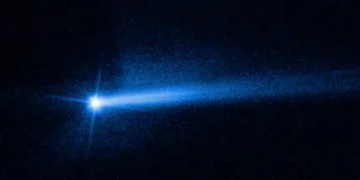NASA’s DART mission, meant to defend Earth from dangerous asteroids, has unexpectedly set the stage for the first-ever human-made meteor shower. After smashing into Dimorphos, the resulting space debris might light up Earth’s skies in the coming years, creating a cosmic show like no other. This article dives into the surprising science, why it matters, and what this means for the future of space exploration.
DART Mission Overview: A Bold Step in Planetary Defense
NASA’s DART mission, launched in 2022, was the first of its kind—a kinetic impactor designed to test whether a spacecraft could alter the trajectory of an asteroid. The target was Dimorphos, a small moonlet orbiting the larger asteroid Didymos. In a spectacular display of precision, DART successfully collided with Dimorphos, changing its orbit and proving that it’s possible to deflect potentially dangerous space rocks away from Earth. This mission marked a pivotal moment in planetary defense, as it was the first time humanity physically altered the motion of a celestial body in space.
However, the impact did more than just change Dimorphos’ path; it also released millions of tiny fragments into space. According to new research, these fragments could eventually reach Earth’s atmosphere, resulting in what researchers are calling the “Dimorphids,” the first human-made meteor shower.
The Science Behind the Meteor Shower: From Impact to Atmospheric Entry
When DART collided with Dimorphos, it blasted debris far beyond the asteroid, creating a plume of rocks, dust, and fragments. Observations from NASA’s Hubble Space Telescope and the European Space Agency’s (ESA) Light Italian Cubesat for Imaging of Asteroids (LICIACube) revealed that about 3 million small rock fragments were ejected during the impact.
These fragments vary in size, some as small as dust particles and others up to four inches across, traveling at speeds of up to 3,350 mph.
Simulations have shown that the fastest-moving fragments could reach Earth in as little as seven years, while the larger, slower particles might take up to 30 years to arrive. Despite their relatively small size, these fragments are moving quickly enough to burn up upon entering Earth’s atmosphere, creating luminous streaks that we see as meteors. Importantly, these “Dimorphids” will pose no threat to our planet but will instead offer a dazzling display of human ingenuity colliding with the cosmos.
Why This Matters: The Unseen Impacts of Planetary Defense
The potential for the first human-caused meteor shower highlights the unintended but fascinating consequences of space missions like DART. While the primary goal was to demonstrate a viable method for asteroid deflection, the creation of the Dimorphids adds a layer of scientific intrigue.
This event not only marks a technical achievement in planetary defense but also opens up new opportunities for studying how artificial impacts influence the behavior of debris in space.
Furthermore, this phenomenon underscores the importance of understanding the broader effects of human intervention in space. The data collected from DART and subsequent missions like ESA’s planned survey of the Didymos system will provide valuable insights into the physics of impact ejecta—knowledge that could refine our strategies for future asteroid deflection missions and deepen our understanding of cosmic collisions in general.
The Future of Meteor Observations: What We Can Learn
The potential arrival of Dimorphids also sets the stage for future observational campaigns. Scientists will closely monitor Earth’s skies and Mars for signs of these meteors, using them as a natural experiment to study the outcomes of kinetic impacts. Observations of the Dimorphids will help validate models of debris trajectories and impact physics, offering a rare opportunity to witness the long-term effects of an artificial collision on a planetary scale.
One of the most exciting aspects is that the Dimorphids are not just a spectacle; they are a scientific tool. Researchers will be able to track the debris’ arrival times, velocities, and patterns, refining their models of how ejecta behave in the vacuum of space. This knowledge could prove invaluable in designing future missions and enhancing our capability to predict the behavior of natural and artificial debris in orbit.
Conclusion: A New Chapter in Human Interaction with the Cosmos
The potential for a human-made meteor shower is more than just an exciting skywatching event; it’s a testament to our growing influence on the cosmos. NASA’s DART mission has not only demonstrated that we can protect our planet from celestial threats but also revealed that our actions in space can have unintended and spectacular consequences. As we continue to push the boundaries of exploration, the Dimorphids remind us that every mission has the potential to create unexpected legacies, linking human innovation with the vast, untamed universe.
As we look to the future, the arrival of the Dimorphids will serve as a visible marker of a new era in space exploration—one where human actions can shape not just the course of an asteroid but the very sky above us. So, keep an eye on the heavens in the years to come; the first human-made meteor shower might just be the next great chapter in our story among the stars.
Reference:
Peña-Asensio, E., et al. (2024). Delivery of DART Impact Ejecta to Mars and Earth: Opportunity for Meteor Observations. The Planetary Science Journal.



















